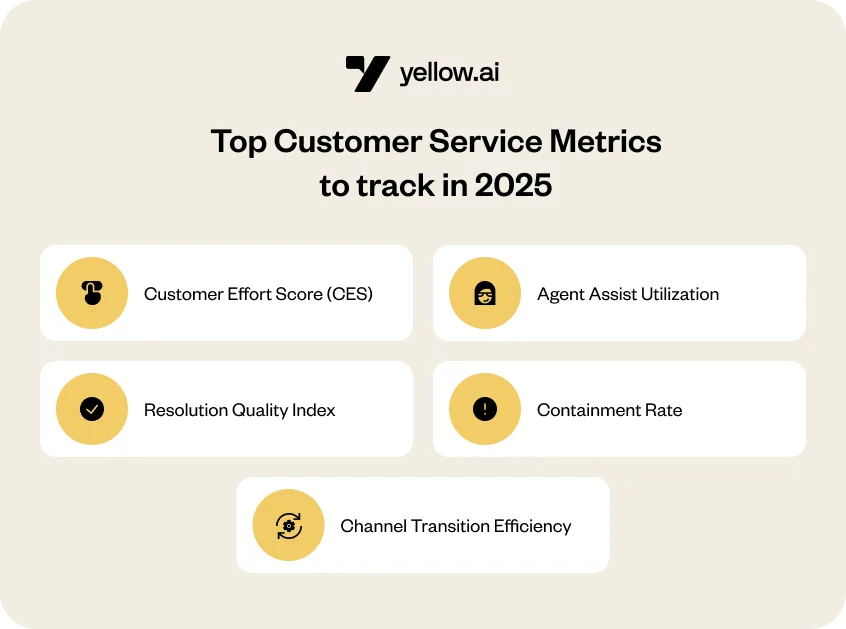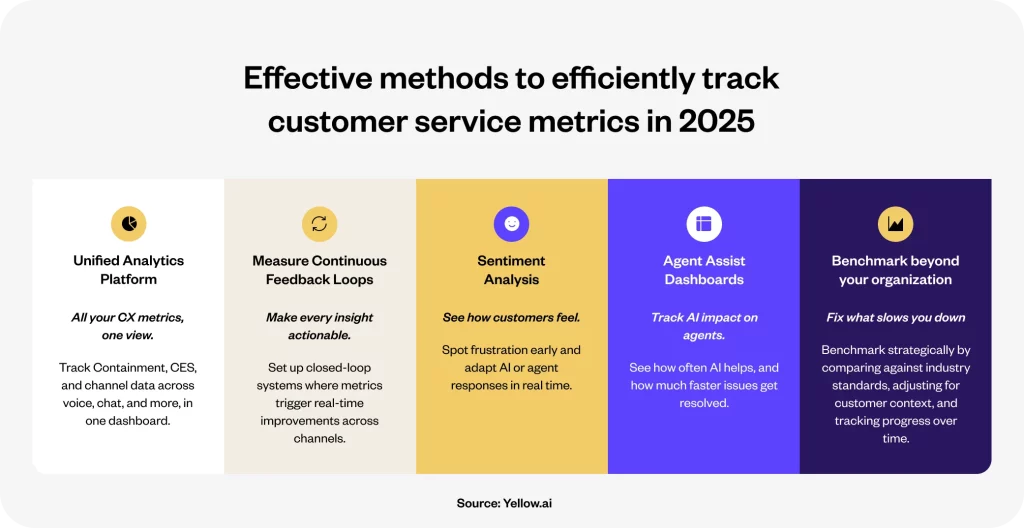Since the inception of customer service, customer service has fundamentally centered around customers – their satisfaction, time, and experience. Yet historically, service operations have been architected around operational efficiency and cost reduction rather than genuine customer needs. These traditional models, while functional, imposed significant limitations that put internal metrics ahead of customer outcomes. In 2025 the game has been flipped on its head.
Today’s customers expect not just fast responses, but frictionless, personalized, and emotionally intelligent experiences, across any channel they choose.They want their queries resolved with efficiency and minimal effort on their part. The lines between digital, human, and AI-powered services seem to be blurring fast.
Meanwhile, AI and automation are redefining what “success” looks like behind the scenes. It’s not just about how quickly you respond, nor is it optimizing internal metrics like handle time – but how intuitively you can understand, assist, and anticipate your customers’ needs even before they even express them.
In this blog, we’ll unpack how customer service metrics are evolving and why traditional metrics alone are no longer enough, and which customer service metrics you should prioritize to thrive in in this era.
Why Traditional Customer Service Metrics Are No Longer Enough
Customer service metrics act as a north star for CX teams, offering critical visibility into what’s working, what’s not, and where strategic adjustments can lead to better customer satisfaction, operational efficiency, and revenue growth. That said, although metrics like Customer Satisfaction Score (CSAT) and Average Handle Time (AHT) continue to hold value, they only tell a part of the story and are not enough. Businesses today need to go deeper, measuring emotional impact, ease of resolution, and the performance of AI-driven service touchpoints to truly understand and improve the end-to-end customer experience.
With the rise of more self-service platforms, AI agents, and hybrid human-AI collaboration models, businesses must now measure not just the outcome, but the customer service experience itself. The new measurement framework demands answers to:
- How effortless was the interaction from the customer’s perspective?
- Did the customer feel better after the interaction than before?
- How effortless was the interaction from the customer’s perspective?
- Did the customer feel better after the interaction?
- Did AI automation enhance the experience, or create new friction?
Why Measuring Smarter Matters in the Age of AI Customer Service
With AI agents now deeply embedded across voice, chat, email, and social channels, the way organizations measure service success need to evolve. The old playbook focused on human agents; how fast they answered, how many tickets they closed. But when AI handles the majority of interactions, these metrics miss the mark entirely.
AI-driven customer interactions transform the service landscape through new elements like automation effectiveness, emotional authenticity, self-service success rates, and blended human-AI support results. Today’s businesses must evaluate not only whether AI resolves customer issues but how empathetically and efficiently it performs across all interaction points.
Pro Tip: Modern CX automation platforms have advanced AI analytics where the AI autonomously evaluates conversation effectiveness using containment rate, sentiment analysis and more. These powerful insights help not just how well the AI agents are performing but also identify opportunities to improve both automation rates and customer satisfaction.
Experiential Customer Service Metrics vs Operational Customer Service Metrics
In 2025’s AI-enhanced service landscape, successful organizations need both experiential metrics (customer perception and emotion) and operational metrics (efficiency and performance). Neither tells the complete story alone but together they provide the balanced view necessary for service excellence.
| Metric Type | Focus Area | Key Metrics | Business Impact |
| Experiential Metrics | How customers feel | • Customer Effort Score (CES) • Sentiment Shift Score • Net Promoter Score (NPS) • Journey Completion Rate | Drives long-term loyalty, brand perception, and customer retention |
| Operational Metrics | How efficiently service is delivered | • First Contact Resolution (FCR) • Containment Rate • Agent Assist Utilization • Cost Per Resolution (CPR) | Ensures profitability, resource optimization, and service scalability |
The Top 5 Customer Service Metrics to Track in 2025
1. Customer Effort Score (CES) for AI-enhanced ecosystems
Customer Effort Score (CES) measures how easy or difficult customers find it to resolve an issue or complete a specific interaction with your company. Instead of focusing solely on satisfaction or speed, CES specifically evaluates the effort customers must invest, reflecting their overall ease of experience.
How to Calculate Customer Effort Score (CES)
CES is typically calculated using a single survey question such as, “On a scale of 1-7, how much effort was required to get your issue resolved?” While customer perception remains valuable, modern CES can incorporate:
- Behavioral metrics: AI can analyze interaction patterns (clicks, navigation paths, time spent)
- Conversation analysis: NLP can detect frustration signals, repeated questions, or tonal shifts
- Resolution pathway tracking: Measuring steps required to complete service journeys
- Predictive effort scoring: AI can assign effort scores based on similar historical interactions
Formula: Enhanced CES = Weighted combination of (Behavioral Signals + Conversation Analysis + Resolution Steps + Customer Feedback)
Tips to Improve Customer Effort Score (CES)
- Design adaptive interfaces that simplify based on real-time effort assessment
- Implement journey analytics that automatically flag high-effort interaction patterns
- Deploy AI that can detect frustration signals in text, voice, and navigation behavior
- Create feedback loops where AI self-improves based on effort score trends
- Use predictive modeling to identify potential high-effort scenarios before they occur
2. Containment Rate
Containment Rate helps you understand how well your automated tools, like chatbots or voice assistants, solve customer issues without needing human intervention. A strong containment rate means your AI is tackling queries efficiently, freeing your human team for more complex, high-impact conversations.
How to Calculate Containment Rate
Take the total number of issues solved entirely by your automated systems, divide by the total number of customer inquiries, and multiply by 100 to get a percentage. Higher percentages reflect smarter, more capable automation.
Formula: Containment Rate (%)=(Total Issues Received/Issues Resolved by Automation)×100
Tips to Improve Containment Rate
- Keep analyzing escalation reasons and update AI training to cover missing intents or misunderstood queries.
- Regularly enrich the AI knowledge base with FAQs, policies, and real-world conversation data.
3. Agent Assist Utilization
Agent Assist Utilization measures how frequently your customer service agents use AI-powered tools or suggestions to handle customer interactions. A higher utilization rate indicates agents are effectively leveraging AI to boost their efficiency, accuracy, and confidence.
How to Calculate Agent Assist Utilization
Divide the number of interactions where agents actively used AI assistance by the total number of agent-handled interactions. Multiply by 100 to get a percentage.
Formula: Agent Assist Utilization (%)=(Total Agent Interactions/Interactions with AI-Assisted Agent Actions)×100
Tips to Improve Agent Assist Utilization
- Integrate AI recommendations directly into agent workspaces, eliminating the need to switch tabs
- Highlight successful AI-assisted resolutions to build agent trust
- Create agent feedback loops that improve AI suggestions over time

4. Resolution Quality Index
Resolution Quality Index (RQI) measures the comprehensive effectiveness of issue resolution, going beyond simple “resolved/not resolved” binary outcomes to evaluate completeness, accuracy, and long-term solution viability across both AI and human touchpoints.
How to Calculate Resolution Quality Index
RQI combines multiple resolution factors into a composite score RQI combines multiple weighted resolution factors into a composite score based on their importance to your specific business context:
- Customer Satisfaction (CSAT): Did the customer feel happy with the resolution?
- Internal Quality Score: Did the agent follow the right process, tone, and steps?
- First Contact Resolution (FCR): Was the issue solved in one go, without follow-ups?
- Durability: Did the resolution prevent the same issue from recurring?
Where:
- w₁, w₂, w₃, and w₄ are weights that sum to 1.0
- Each component is rated on a 0-100 scale
- Weights should reflect your organization’s priorities (e.g., for critical services, durability might be weighted higher)
Formula: RQI = (w₁ × Accuracy) + (w₂ × Completeness) + (w₃ × First-Time-Right) + (w₄ × Durability)
Tips to improve Resolution Quality Index (RQI)
- Implement post-resolution verification checks by both AI and quality assurance teams
- Create comprehensive knowledge management systems that capture complete solutions
- Analyze recurring issues to identify and address root causes rather than symptoms
- Track resolution quality differences between AI-only, human-only, and hybrid interactions to identify improvement opportunities in each channel
- Regularly review component weights to ensure they align with changing business priorities
5. Channel Transition Efficiency
Channel Transition Efficiency (CTE) measures how seamlessly customer context and history transfer when interactions move between service channels (e.g., chatbot to live agent, voice to chat, email to messaging). In 2025’s omnichannel environment, this metric is critical for evaluating whether your service ecosystem functions as a cohesive whole rather than disconnected silos.
How to Calculate Channel Transition Efficiency
CTE evaluates transition quality through a weighted combination of key factors:
Formula: CTE = (w₁ × Context Retention) + (w₂ × Time Efficiency) + (w₃ × Customer Effort) + (w₄ × Resolution Continuity)
Tips to Channel Transition Efficiency
- Integrate AI recommendations directly into agent workspaces, eliminating the need to switch tabs
- Highlight successful AI-assisted resolutions to build agent trust
- Create agent feedback loops that improve AI suggestions over time
Where:
- Context Retention (0-100): Percentage of relevant customer information and history maintained during transition
- Time Efficiency (0-100): How quickly service resumes after channel transition (inverse of delay time)
- Customer Effort (0-100): Inverse of information customers must repeat during transitions
- Resolution Continuity (0-100): Whether the resolution path continues logically across channels
- Weights (w₁, w₂, w₃, w₄) sum to 1.0 and reflect your priorities (e.g., retail might emphasize speed, healthcare might prioritize context retention)
Effective Methods to Efficiently Track Customer Service Metrics
As AI transforms customer service, organizations need sophisticated approaches to measurement that capture both human and automated interactions. Here are four proven methods that leading companies use to gain holistic visibility:

Using a Unified Analytics Platform
Traditional siloed measurement, separate dashboards for chat, voice, email, and social, creates blind spots in understanding the complete customer journey. Modern service operations require a unified view.
Implementation Strategy:
- Consolidate data from all channels (AI and human) into a central analytics platform
- Apply consistent measurement frameworks across channels to enable direct comparisons
- Implement unique customer identifiers that track journeys across touchpoints, regardless of channel switches
Real-World Impact: A global telecommunications provider unified their analytics across 11 service channels and discovered that customers who switched channels midway through resolution were 3x more likely to churn. This insight led to improved handoff protocols that reduced channel-switching by 47%.
Embedding Sentiment Analysis in Every Interaction
Just measuring operational outcomes is not enough, here emotion is the real loyalty driver.
By embedding sentiment analysis into both AI-led and human-led conversations, you can track emotional shifts in real-time, detecting frustration early and personalizing interventions.
Strategic Insight – Research done by PwC shows that 32% of customers will leave a brand they were loyal to after just one bad emotional experience.
Select automation platforms which have the following built-in capabilities:
- NLP to detect emotional signals in real-time across text and voice
- Tracking emotional shifts throughout interactions, not just end-state satisfaction
- Intervention triggers when negative sentiment is detected
Leveraging Real-Time Agent Assist Dashboards
The most successful service organizations don’t measure AI and human performance separately, they measure how effectively they work together. Agent Assist Utilization is one of the clearest indicators of how mature and future-ready your service operations really are. Tracking Agent Assist Utilization gives you a real-time pulse on:
- Adoption rates across teams
- Trust levels in AI recommendations
- Training and knowledge base gaps for both human and AI agents
- Workflow inefficiencies
- Opportunities to optimize both human performance and AI models
Without this lens, you’re missing one of the most powerful ways to accelerate agent productivity and amplify your automation ROI.
Key Agent Assist Dashboard Elements:
– AI suggestion adoption rates by agent and query type
– Agent feedback on AI recommendations
– Improvement rate of AI recommendations based on agent input
– Comparative resolution times for AI-assisted vs. unassisted interactions
– Knowledgebase gap identification and recommendations
Continuous Feedback Loops
Static measurement fails in today’s dynamic service environment. Leading organizations implement closed-loop systems where insights automatically drive improvements.
Implementation Framework:
- Establish baseline performance metrics across channels and interaction types
- Create automated triggers that flag significant deviations from expected outcomes
- Implement A/B testing for service improvements based on metrics insights
- Measure both immediate and long-term impacts of service changes
Success Story: An e-commerce company implemented automated testing of AI responses based on sentiment analysis feedback. Their system continuously refined messaging based on customer emotional responses, leading to a 23% improvement in positive sentiment during automated interactions over six months.
Benchmarking Beyond Your Organization
Context matters in measurement. Top-performing companies regularly benchmark their metrics against industry standards while accounting for their unique customer base.
Benchmarking Strategy:
- Compare metrics across industry peers and service leaders from other sectors
- Normalize metrics based on customer demographics and complexity factors
- Identify performance gaps and conduct targeted improvements
- Re-benchmark quarterly to track progress
Real-World Example: A healthcare provider struggling with first contact resolution discovered through benchmarking that their metrics were actually industry-leading when adjusted for case complexity. This insight shifted their focus from general improvement to specifically enhancing complex-case handling, where the greatest competitive advantage could be gained.
How to Measure Smarter with Yellow.ai
Enterprise service organizations face unique challenges: complex channel ecosystems, legacy integration requirements, and the need to demonstrate clear ROI from technology investments. Yellow.ai addresses these enterprise realities through:
Enterprise-Grade Analytics Architecture: Consolidate data across fragmented channels, legacy systems, and global operations into a unified analytics framework that meets enterprise security and compliance requirements.
Strategic Insight Delivery: Convert raw service data into executive-ready insights that connect CX metrics to business outcomes across regions, products, and customer segments.
Robust Integration Ecosystem: Seamlessly connect with existing enterprise systems like Salesforce, SAP, and ServiceNow to create a complete view of customer interactions without creating new data silos.
Governance and Scale Deploy consistent measurement standards across global operations while maintaining the flexibility to address regional variations in regulatory and market requirements.
Yellow.ai brings enterprise-level rigor to customer service measurement, enabling complex organizations to translate service insights into tangible business results across diverse, multinational operations.
Conclusion: Focus on Meaning not Metrics
The future of customer service isn’t about accumulating more data; it’s about extracting deeper meaning.
In 2025, winning organizations won’t differentiate on operational excellence or emotional intelligence alone, but on how seamlessly they blend both across AI and human touchpoints. The metrics that matter most are those that illuminate the complete customer journey, revealing both operational efficiency and emotional impact.
As you evolve your measurement approach, remember that the goal isn’t good looking reports with varied metrics, it’s a more meaningful understanding of what drives customer loyalty in your unique context.
The organizations that thrive will be those that transform measurement from a reporting function into a strategic advantage that continuously improves both the science and art of customer connection.
Frequently Asked Questions (FAQ’s)
What are Customer Service Metrics?
Customer service metrics are essential tools that help organizations evaluate the effectiveness of their support operations. By tracking key indicators like response time, resolution rate, and customer satisfaction, businesses gain clear, actionable insights into what’s working and what needs improvement.
Why is Customer Effort Score more important than ever?
Customer Effort Score (CES) has become one of the most predictive metrics for loyalty in 2025. It measures the ease of customer interactions – a low-effort experience typically leads to higher retention, better reviews, and stronger NPS scores. It’s especially critical in AI-first service environments where speed alone doesn’t guarantee satisfaction.
How do I start measuring customer service smarter?
Here’s how to modernize your CX metrics approach:
- Unify analytics across voice, chat, and email (AI + human)
- Embed sentiment analysis in every touchpoint
- Track AI and agent collaboration through dashboards
- Close the loop by linking insights to real-time improvements
What are the key customer service metrics to track in 2025?
In 2025, it’s no longer just about speed or ticket volume. The most valuable customer service metrics include:
- Customer Effort Score (CES) – How easy was it for the customer to get help?
- Containment Rate – How effectively can AI agents resolve queries without escalation?
- Sentiment Shift Score – How does customer emotion change during the interaction?
- Agent Assist Utilization – How often do agents rely on AI recommendations?
- Resolution Quality Index (RQI) – A weighted measure of CSAT, accuracy, and first-contact resolution.
These metrics give a full picture of both emotional experience and operational performance.
Empower your customer service with Yellow.ai

















